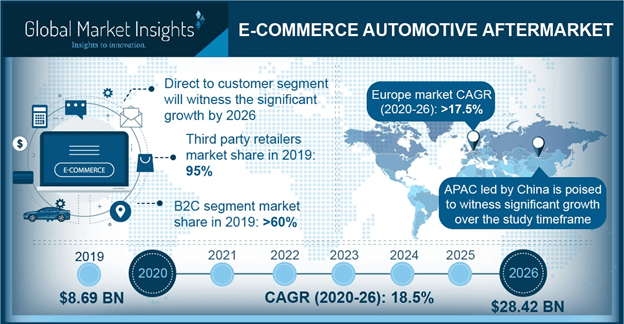China e-commerce automotive aftermarket industry to accrue extensive gains over 2018-2025, driven by the adoption of lucrative growth strategies by automakers and e-commerce giants
Publisher : Fractovia | Published Date : 2018-02-01Request Sample
The automotive sector has undergone a digital transformation in recent times, the impact of which has heavily fueled e-commerce automotive aftermarket. Numerous automakers have been implementing software-based services lately, such as electronics inventory management systems, for the distribution of automotive parts, on the grounds of which joint ventures between e-commerce giants and automotive behemoths is rather palpable. For instance, recently in 2017, Chinese e-commerce behemoth, Alibaba partnered with Ford to boost automotive sales across China. It has been observed that the surging involvement of e-commerce service providers and automakers along with the emergence of the Internet of Things will have a rather considerable impact on e-commerce automotive aftermarket industry share. Currently, the automotive sector has also been getting more competitive, with the business space being shared among numerous players. In order to consolidate their position, some of the top automakers have been working toward replacing the traditional methods of distribution with internet-based distribution models. The widespread deployment of digital business models in tandem with the adoption of online channels is thus likely to fuel e-commerce automotive aftermarket industry size.
U.S. E-commerce Automotive Aftermarket, By Consumer, 2017 & 2025, (million units)

E-commerce techniques such as paperless transactions and online auctions have helped minimize product cost and enhanced efficiency. In addition, these techniques have proved to be effective in building relationships with suppliers and buyers, further leading to a rise in cost savings, technological advancements, and manufacturing high quality products. On these grounds, many giants in e-commerce automotive aftermarket and leading automakers are strongly focusing on adopting e-commerce tools like cloud computing and social networking for information exchange. A few years earlier, for example, one of the global automotive leaders, Toyota Motor Corporation, deployed an e-commerce practice across the organization, which apparently had a huge impact on TMC’s profit, productivity, savings, B2B relations, and supply chain management. The installation of innovative advancements such as software-based e-commerce facilities and QR technology within the organization helped TMC to strengthen its leadership stance in e-commerce automotive aftermarket.
It has been observed that numerous other automakers such as GM, Daimler-Chrysler, and Ford have also launched facilities for the online exchange of products, establishing their position in e-commerce automotive aftermarket industry. Online auctioning portals have turned out to be quite beneficial for these companies to compete for customers depending on their requirements such as delivery time, quality, and price, expanding the scope of the B2C business model. According to Global Market Insights, e-commerce automotive aftermarket is poised to collect hefty proceeds from the B2C segment, with an annual growth rate of more than 20% over 2018-2025.
The automobile sector has indeed been heavily benefitted from the advent of e-commerce. Subject to the installation of e-commerce facilities such as supply chain integration models, OEMs can gather information very efficiently and generate a smooth flow between internal divisions, suppliers, distributors, and customers, and emerge to a viable growth ground for e-commerce automotive aftermarket industry. Currently, most of the automotive manufacturers have installed CRM and ERP systems for improving the company’s profile and performance parameters. Easy accessibility for aftermarket products like braking accessories, spark plug, universal joints, filters, gaskets, lightening system, and wipers with the help of e-commerce software solution will indeed have a remarkable impact on ecommerce automotive aftermarket outlook.
At a regional level, numerous automakers have been collaborating with local e-commerce firms to increase their overall worth. The 2017 partnership between Alibaba and Ford for instance, granted reciprocal benefits to both the firms – while Alibaba helped Ford increase its car sales, Ford involved Alibaba in its current innovative connected car concept, incorporating Alibaba’s cloud-computing platform. Through this agreement, and many more related ones, China, in addition to being one of the largest automotive market, will also emerge to be a major growth avenue for e-commerce automotive aftermarket. Driven by the increasing deployment of regulatory norms related to energy efficiency, the demand for EVs is also expected to rise across the country, further propelling China e-commerce automotive aftermarket share.
As of now, digitalization has emerged to be a major driving force responsible for the transformation across the global automotive space. The growing acceptance of the internet, smartphones, and cellular and wireless communication is slated have a large-scale influence on e-commerce automotive aftermarket size. Having recognized the importance of e-commerce across automotive sector, the players in e-commerce automotive aftermarket including Advance Auto Parts, Amazon, Denso Corporation, Bosch, AliExpress, Flipkart, Napa Auto Parts, and E-bay are working constantly to improve the infrastructure of online portals. The surging investments in online facility enhancements with the help AI and IoT are indeed likely to stimulate e-commerce automotive aftermarket trends over the years ahead.